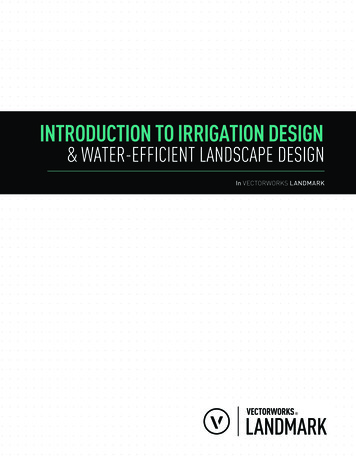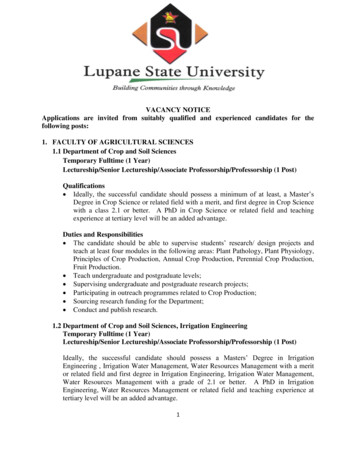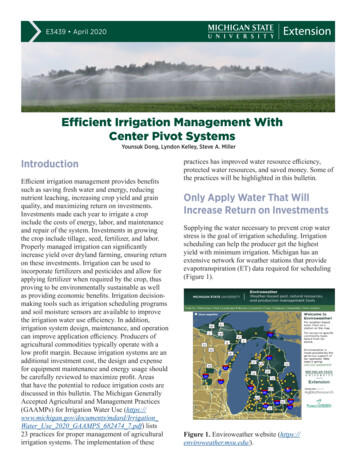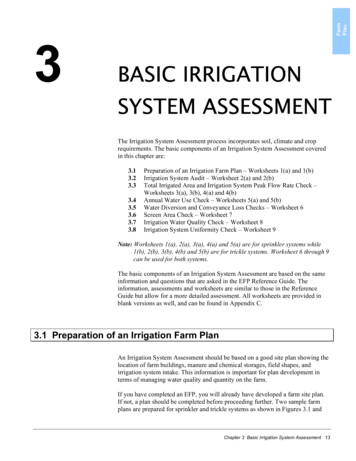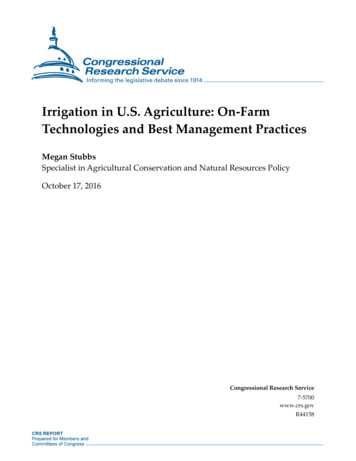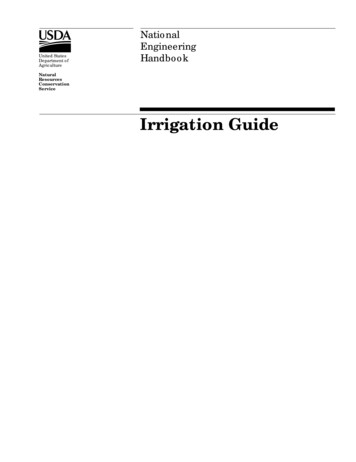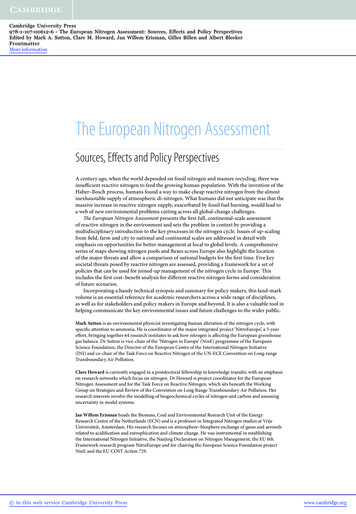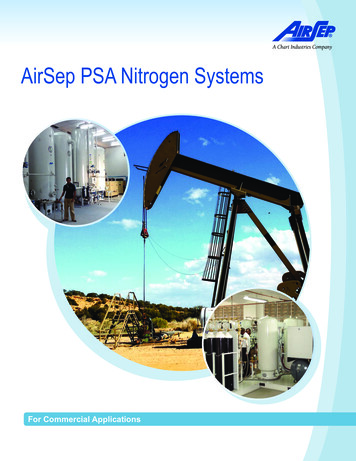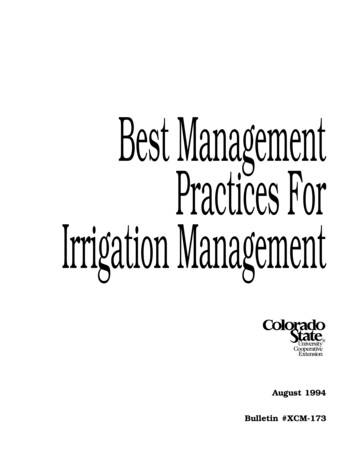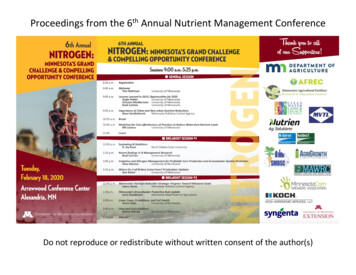
Transcription
Proceedings from the 6th Annual Nutrient Management ConferenceDo not reproduce or redistribute without written consent of the author(s)
Irrigation and nitrogenmanagement for profitable cornproduction and groundwaterquality protectionVasudha SharmaAssistant Extension ProfessorIrrigation and Water QualityUniversity of Minnesota Twin Citiesvasudha@umn.eduSIXTH ANNUAL NITROGEN: MINNESOTA’S GRANDCHALLENGE & COMPELLING OPPORTUNITY CONFERENCE
Outline Importance of irrigation in Minnesota Importance of irrigation management Irrigation management research projects in Minnesota22 2020 Regents of the University of Minnesota. All rights reserved.
Irrigation- Why is it important? Irrigation plays an important role in Minnesota’s Ag economy Data from 2009-2018 from 9 irrigated counties in CentralSands regions shows that Irrigated corn was 56% more profitable than nonirrigated corn Irrigated soybeans were 75% more profitable thannon-irrigated soybeans There are more than 650,000 acres or irrigated land in MN 17% increase in Irrigated acreage from 2012-2017 (USDA2017)Sources: .pdf 2020 Regents of the University of Minnesota. All rights reserved.
Irrigation- Why is it important?Sources: MN DNR MPARS permitting database44 2020 Regents of the University of Minnesota. All rights reserved.
Irrigation- Why is it important? Many streams does notmeet water qualitystandards for aquatic life Shallow wells (less than 30feet deep) havehigher nitrateconcentrationsWater Table Aquifer VulnerabilitySources: q-am1-10.pdf 2020 Regents of the University of Minnesota. All rights reserved.55
What is Irrigation Management? Irrigation Water Management is the process ofdetermining and controlling the volume, frequency, andapplication rate of irrigation water in a planned, efficientmanner. Benefits: Manage soil moisture to promote desired crop responseDecrease non-point source pollution of surface andgroundwater resources Optimize the use of available water supplies Manage air, soil or plant micro-climate Minimize irrigation induced erosion66 2020 Regents of the University of Minnesota. All rights reserved.
Irrigation management strategies Several irrigation management strategies have apotential in reducing nitrate-N losses due toleaching and runoff: Irrigation scheduling Deficit/limited irrigation management Variable rate irrigation77 2020 Regents of the University of Minnesota. All rights reserved.
Research questions Which irrigation scheduling methods is best inreducing nitrate leaching to groundwater, whilemaintaining optimum corn yields. Will reduction in irrigation rates (usingdeficit/limited irrigation management) reduce theN fertilizer requirement and nitrate leaching?88 2020 Regents of the University of Minnesota. All rights reserved.
Soil water and plant growthManagementallowabledepletion99 2020 Regents of the University of Minnesota. All rights reserved.
How can we manage irrigation efficiently? Irrigation schedulingWhen to irrigate?(Timing)How much water?(Amount)Turn the systemONTurn the systemOFF1010 2020 Regents of the University of Minnesota. All rights reserved.
Irrigation Scheduling MethodsSimple Visual Observation- Hand feel or neighbor Measure real-time moisture status- Soil moisture sensors Estimate soil water deficit in the root zone- weather data Modelling techniquesComplex1111 2020 Regents of the University of Minnesota. All rights reserved.
Irrigation scheduling methods: Research Site: Sand Plain Research Farm,Becker and Rosholt Farm, Westport Variable rate irrigation system atboth locations allowed irrigatingsmall plots without overlap Four irrigation schedulingtechniques were evaluated,replicated 3 times in a randomizedcomplete block design1212 2020 Regents of the University of Minnesota. All rights reserved.
Irrigation scheduling treatments Four treatments were: Soil moisture monitoring using soil moisture sensorsSoil based Checkbook Method- weather and soil based Irrigation Management Assistant (IAM): 100% CropEvapotranspiration (ETa) replacement- weather andsoil based Crop Growth Model (EPIC)Details about each irrigation method is present ion1313 2020 Regents of the University of Minnesota. All rights reserved.
Irrigation scheduling treatmentsFCMADPWPFC- Field CapacityMAD- Management Allowable DepletionPWP- Permanent Wilting Point1. Soil moisture monitored using soilmoisture sensors: using neutron gaugemoisture meter2. Soil moisture estimated usingCheckbook method: using soil waterbalance Dc Dp ETa – P – Irr3. Soil moisture estimated usingIrrigation management assistant tool:using soil water balance Dc Dp ETa– P – Irr4. Soil moisture estimated using EPICcrop growth model: predict real-timeirrigation timing using a thresholdirrigation trigger (likely -150 kPa soilmoisture potential) based on updateddaily weather records.1414 2020 Regents of the University of Minnesota. All rights reserved.
Measurements Soil moisture sensor for moisture monitoring – Neutron probe Suction cup lysimeters to measure nitrate in the water thatpercolates below the root zone Weather station for precipitation Plant sampling (V8, R1 and R6) and soil sampling after harvestfor nitrate for total NNeutron ProbeLysimeterWeather station1515 2020 Regents of the University of Minnesota. All rights reserved.
Irrigation amounts in 2019Becker, MN Total growing season rain 25 inWestport, MN Total growing season rain 21.2 inT1- soil moisture monitoring using soil moisture sensorsT2- University of Minnesota checkbook methodT3- Irrigation management assistant tool (IMA)T4- crop growth model (EPIC)Sharma et al. 2019 unpublished data 2020 Regents of the University of Minnesota. All rights reserved.1616
NO3-N concentration in water belowrooting depth at Becker in 2019Avg. 23.7mg/LAvg. 18mg/LAvg. 26mg/LAvg. 21mg/LSharma et al. 2019 unpublished data 2020 Regents of the University of Minnesota. All rights reserved.1717
NO3-N concentration in water belowrooting depth at Westport in 20196.8 mg/l8.4 mg/l12.5 mg/l6.4 mg/lSharma et al. 2019 unpublished data 2020 Regents of the University of Minnesota. All rights reserved.1818
Cumulative NO3-N leaching (lb/ac) belowthe root zone in four irrigation treatmentsBecker, MNWestport, MNT1- Soil moisture monitoring using soil moisture sensorsT2- University of Minnesota checkbook methodT3- Irrigation management assistant tool (IMA)T4- Crop growth model (EPIC)Sharma et al. 2019 unpublished data 2020 Regents of the University of Minnesota. All rights reserved.1919
Corn grain yield in different irrigationtreatmentsBecker, MNWestport, MNT1- Soil moisture monitoring using soil moisture sensorsT2- University of Minnesota checkbook methodT3- Irrigation management assistant tool (IMA)T4- Crop growth model (EPIC)Sharma et al. 2019 unpublished data 2020 Regents of the University of Minnesota. All rights reserved.2020
Irrigation scheduling methods: Summary Irrigation amounts and timing are different under differentirrigation scheduling methods. NO3-N concentration was highest in Checkbook methodwhich can be attributed to higher irrigation amounts perirrigation after July 25 in that treatment. We observed that plots under IMA irrigation methodproduced comparable yield, with minimal nitrate leachinglosses at both locations Also, IMA tool recommended least amount of irrigation inboth locations.Sharma et al. 2019 unpublished data 2020 Regents of the University of Minnesota. All rights reserved.2121
How can we manage irrigation efficiently? Using deficit/limited irrigation management Will reduction in irrigation rates (using deficit/limitedirrigation management) reduce the nitrate leaching?2222 2020 Regents of the University of Minnesota. All rights reserved.
Experimental design Irrigation and Nitrogen Research atBecker Sand Plain Research Farm Main plots (4) are irrigation levels:100%, 75%, 50% irrigation andrainfed Subplots (6) are nitrogen rates: 0, 70,140, 210, 280 and 350 lb/ac N Four replications : 96 plotsSharma et al. 2019 unpublished data 2020 Regents of the University of Minnesota. All rights reserved.2323
What is 100% Irrigation in our research?FCFCMADMADPWP100% IrrigationPWP75% IrrigationFC- Field CapacityMAD- Management Allowable DepletionPWP- Permanent Wilting Point24 dataSharma et al. 2019 unpublished24 2020 Regents of the University of Minnesota. All rights reserved.
Nitrate-N concentration under 100% and50% Irrigation100% irrigationN rate140 lb/ac280 lb/ac50% irrigationIrrigation50%100%Nitrate-N conc. (mg/L)7.79.89.111.04Sharma et al. 2019 unpublished data 2020 Regents of the University of Minnesota. All rights reserved.2525
Effects of irrigation and nitrogen rates oncorn yield in 2019 Reducing irrigation did not reduce corn grainyield.Sharma et al. 2019 unpublished data 2020 Regents of the University of Minnesota. All rights reserved.2626
Effects of irrigation and nitrogen rates onReturn to N in 2019N( /lb)Corn ( /bu)0.38Sharma et al. 2019 unpublished data 2020 Regents of the University of Minnesota. All rights reserved.3.82727
Deficit/Limited Irrigation Research : Summary Crop yield between Irrigation treatments was notsignificantly different. Maximum Return to Nitrogen ( /ac) wasobtained under 50% irrigation treatmentbetween 210 lb/ac to 250 lb/ac. 2019 data shows that 50% irrigation could besuperior to full irrigation (100%) in wet years like2019.Sharma et al. 2019 unpublished data 2020 Regents of the University of Minnesota. All rights reserved.2828
Variable Rate Irrigation Variable rate irrigation (VRI) is an emerging technologythat may have some merit in Minnesota. Variable rate technologies proper amount of water andfertilizer to specific locations in the fieldStaticprescriptionmapSource: -meets-innovation/2929 2020 Regents of the University of Minnesota. All rights reserved.
Dynamic prescription maps The irrigation requirements based onspatiotemporal variability of the field Researches have used an array of soil moisturesensors or canopy temperature sensors tocapture the field variability The irrigation decision accuracy depends on thenumber of sensors in the large-scale planting area Large-scale deployment of these sensors is noteconomical3030 2020 Regents of the University of Minnesota. All rights reserved.
Variable rate irrigation and nitrogenresearch Our research aimed at usingUnmanned aerial vehicle (UAV) tomonitor variables like NDVI, NDRE,LAI, canopy chlorophyll contentestimation, incident and canopyreflected PAR, canopy and airtemperature, relative humidity andatmospheric pressure. In-season variable rate N andirrigation (drought stress) Diagnosis& Management AlgorithmDevelopment3131 2020 Regents of the University of Minnesota. All rights reserved.
Take home message Irrigation management is very critical in MNespecially in central sands region Efficient irrigation scheduling is maintaining soilwater between field capacity and managementallowable depletion IMA and EPIC irrigation scheduling methodsworked best in terms of reducing nitrate leachingand producing optimum corn grain yield Deficit irrigation management (50% irrigation)helped in reducing N-leaching while maintainingoptimum corn grain yields and maximum returnto nitrogen3232 2020 Regents of the University of Minnesota. All rights reserved.
Thank you!Questions?Vasudha (Vasu) Sharmavasudha@umn.edu 2020 Regents of the University of Minnesota. All rights reserved.The University of Minnesota is an equal opportunity educator and employer. In accordance with the Americans with DisabilitiesAct, this PowerPoint is available in alternative formats upon request. Direct requests to 612-624-1222.3333
What is Irrigation Management? Irrigation Water Management is the process of determining and controlling the volume, frequency, and application rate of irrigation water in a planned, efficient manner. Benefits: Manage soil moisture to promote desired crop response Decrease non-point source pollution of surface and groundwater .
